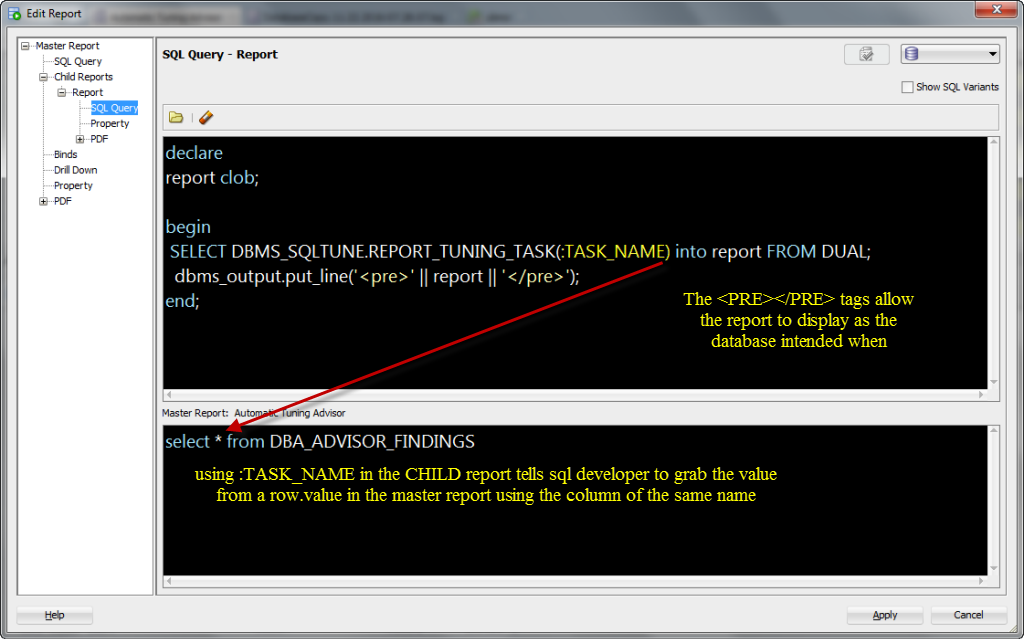Oct 31, 2012 The task is simply taking the most consuming SQL statements, criteria to choose them remains Oracle internals, and execute a SQL Tuning task using SQL Tuning Advisor (STA) that we have already seen in another post. Starting with Oracle 11.2.0.2 you have access to DBMSAUTOSQLTUNE package to manage automatic SQL tuning task. The SQL Tuning Advisor page appears, with the Automatic tab showing. The SQL tuning task that appears on the Automatic tab is the SYSAUTOSQLTUNINGTASK. This tuning task is created daily by the Automatic SQL Tuning Advisor. The task includes any high-load SQL queries for which the Automatic SQL Tuning Advisor has generated tuning. Oracle 12c offers a useful utility called the SQL Tuning Advisor. You can use this built-in tool to provide suggestions or recommendations about certain SQL statements. Although it may not always give perfect advice, just like anything else, having it in your toolbox of tuning techniques is beneficial. Use PL/SQL and the internal package DBMSSQLTUNE. Oracle Database - Enterprise Edition - Version 11.2.0.2 and later: Automatic SQL Tuning SYSAUTOSQLTUNINGTASK Fails With ORA-13605 or ORA-13602. Oracle Database - Enterprise Edition - Version 11.2.0.2 and later: Automatic SQL Tuning SYSAUTOSQLTUNINGTASK Fails With ORA-13605 or ORA-13602.
Oracle 12c offers a useful utility called the SQL Tuning Advisor. You can use this built-in tool to provide suggestions or recommendations about certain SQL statements. Although it may not always give perfect advice, just like anything else, having it in your toolbox of tuning techniques is beneficial.

Use PL/SQL and the internal package DBMS_SQL_TUNE to create a tuning task. Type this:
You should see the following:
In the preceding command, note the TIME_LIMIT of 60. That limits the processing time to 60 seconds. You may not always want to run something like this for long periods in your database, because it incurs system overhead.
Execute the tuning advisor with your task by typing this:
Because of the limit of 60 seconds provided in the task creation, this step may take up to 60 seconds to complete. During this time, your prompt won’t come back.
When it completes, you should see this:
If you’ve set a longer time and are getting impatient, you can open another SQL window to make sure that the task is still executing by typing
You see something like the following:
When the execution is complete, you can view the results by running the BMS_SQLTUNE.report_tuning_task procedure. Type the following:
For the sake of space, we’ve snipped some sections from the output that follows, but you see something like this:
The latter part of the report shows the before and after execution plans. In this case, you’ve seen the before when you were generating execution plans. Go ahead and add the index, regenerate the execution plan, and see whether you’ve made an improvement.
Before you add the index, note that the recommendations give the SQL to add the index:
Also note that Oracle gives a warning:
Add the index with your own name by typing this:
You should see something like the following:
Take a look at the execution plan. Type the following:
And then type
You should see output like this:

Now that you’ve added the index, a few things are evident:
DaisyDisk, chosen by Apple as a Mac App Store ‘essential’, provides a cleaner and more interactive circular interface for visualizing Mac’s hard drive. For only ten bucks, DaisyDisk is a simple. Daisydisk cleaner mac. Jun 14, 2019 DaisyDisk Cleaner is a mac cleaner app which helps you recover a humongous amount of disk space in a few clicks. It enables you to visualize the disk space used and therefore points out.
The cost of the plan dropped from 40336 to 5.
There are now six steps.
The full table scan is gone. Instead you see the use of your new index.
Sql Tuning Advisor In Oracle
Often one of the tough parts about tuning a database is having a solid understanding of the application and the data. The issue might not always be obvious. Sometimes engaging other application and data experts helps.
Oracle Query Tuning
Explain to them your findings and what you propose. They may be able to help you come to a conclusion. Also, if the data is part of a packaged third-party application, sometimes opening a ticket with the vendor is the way to go.